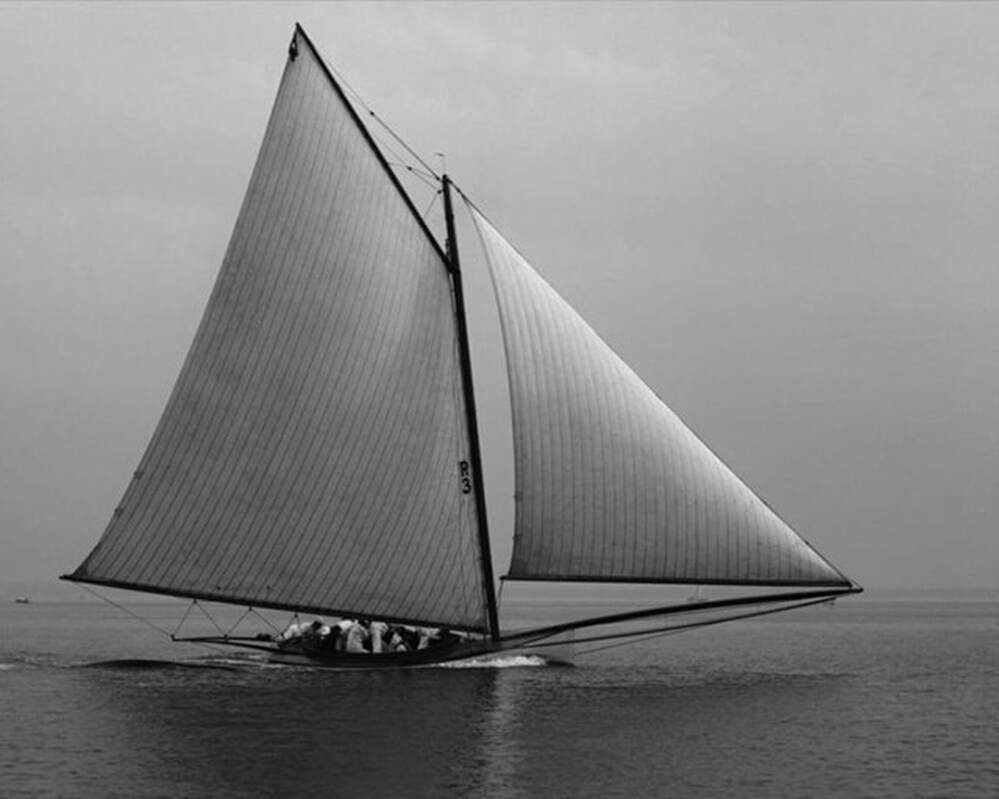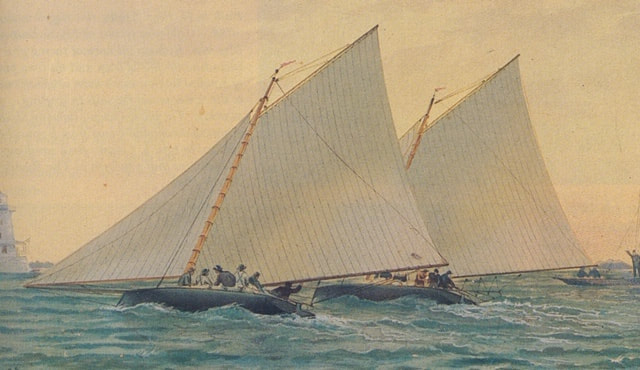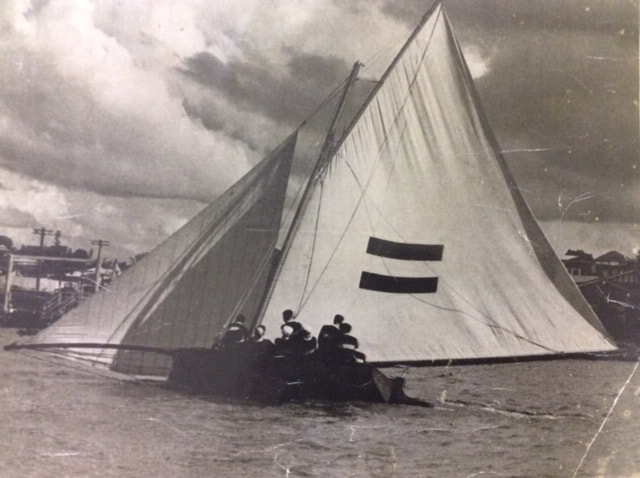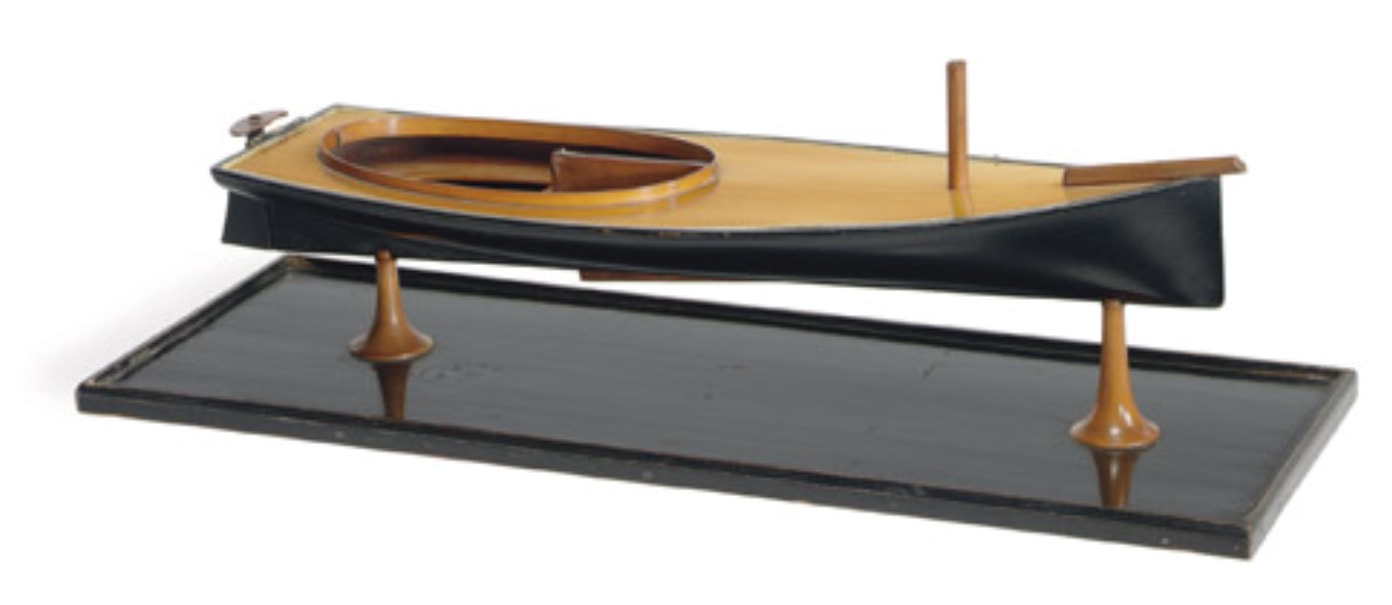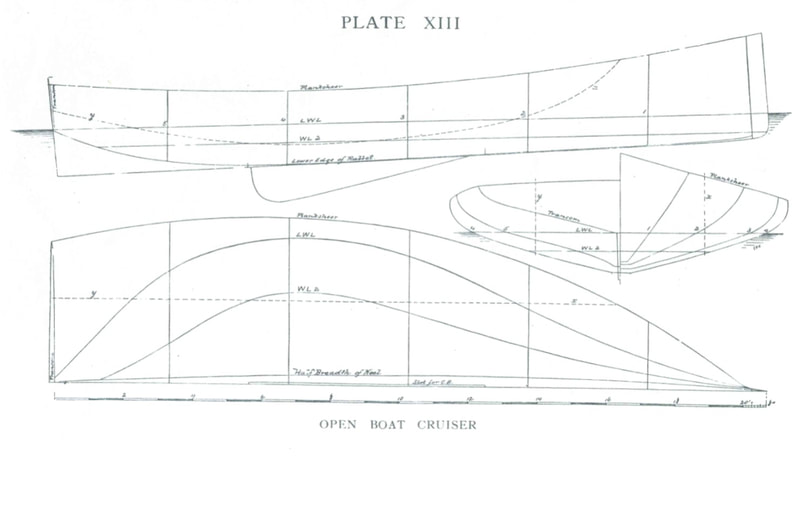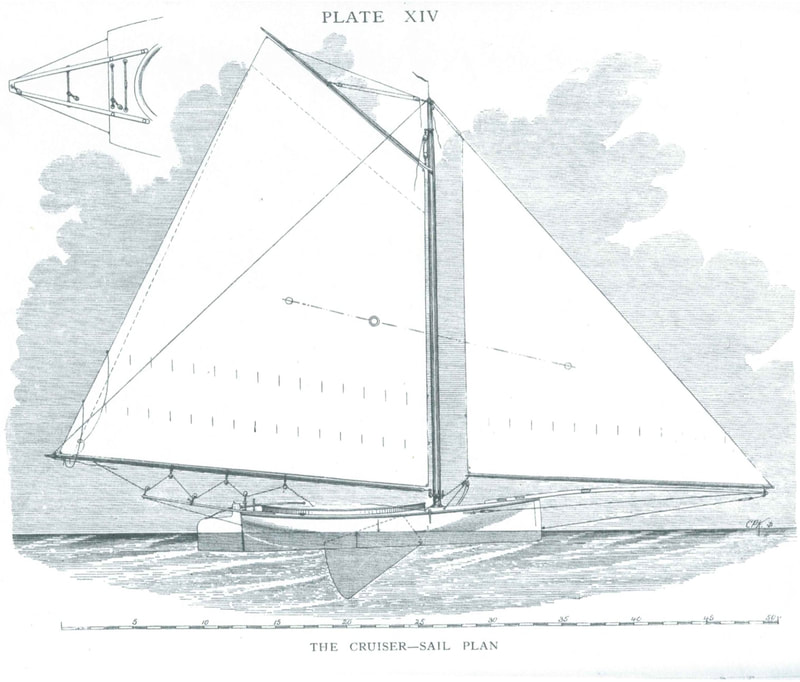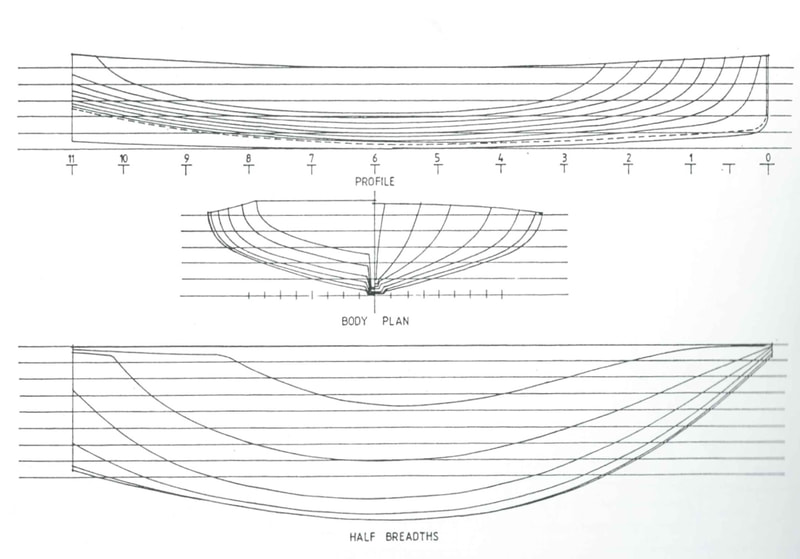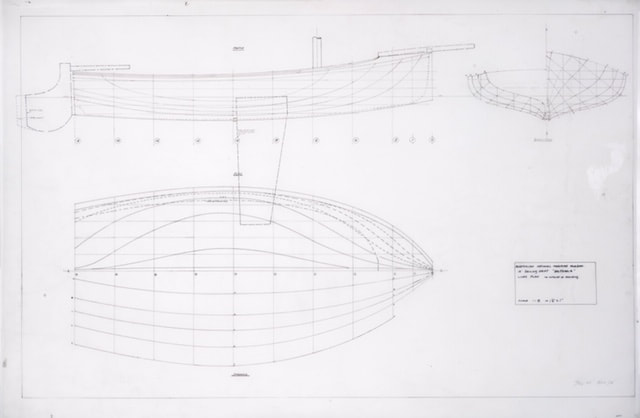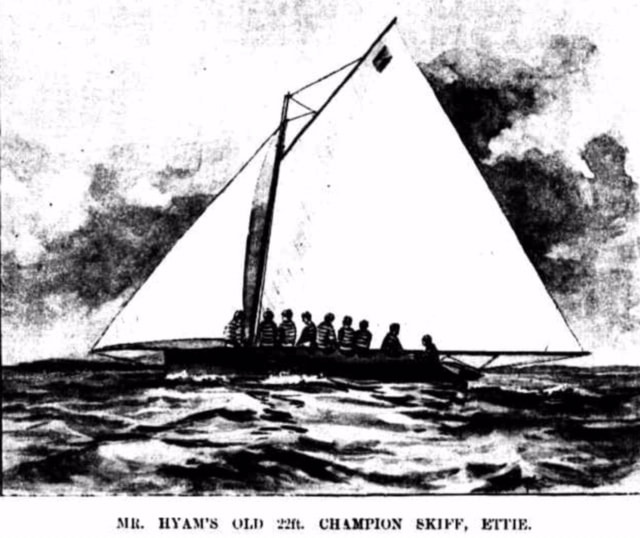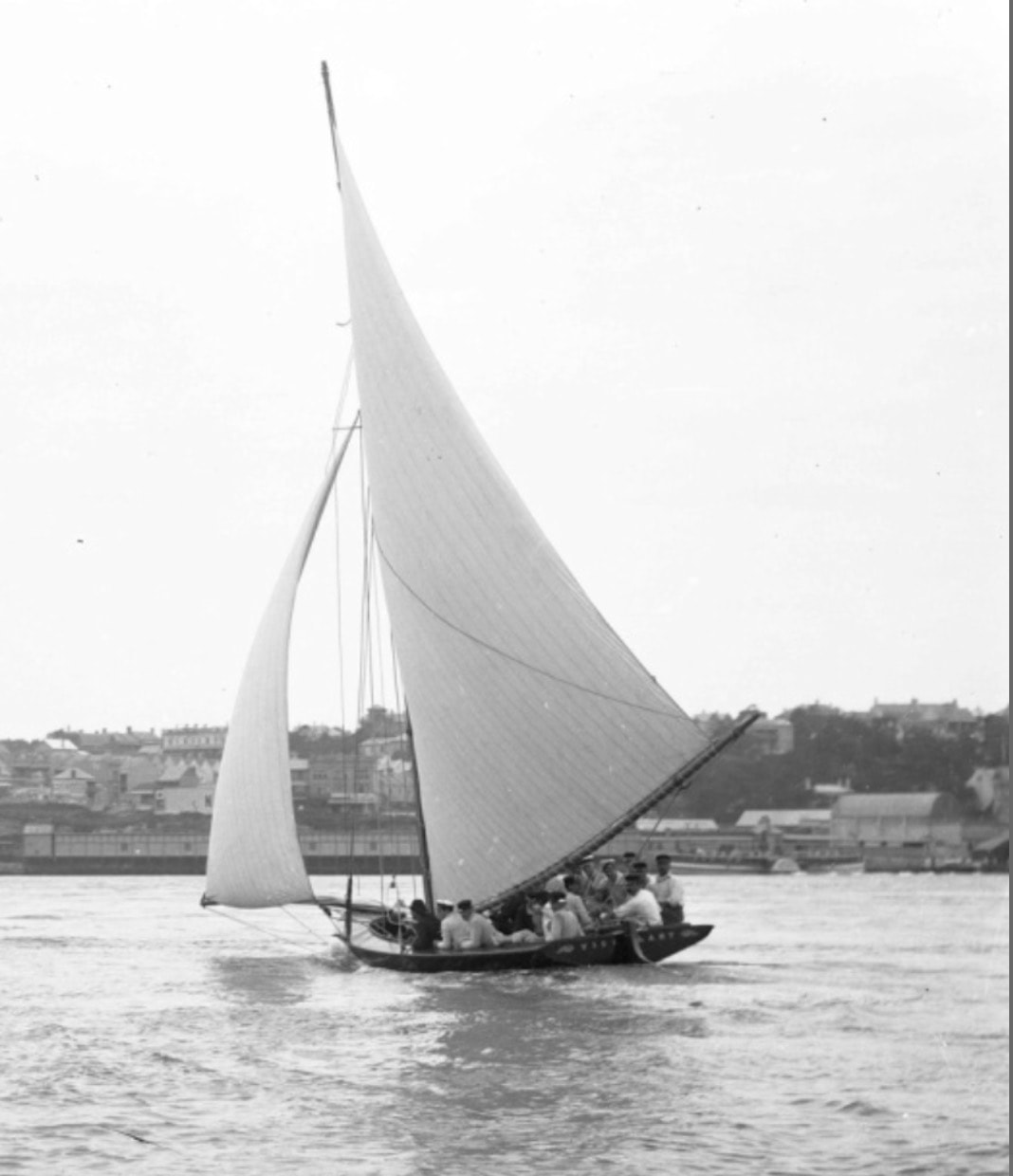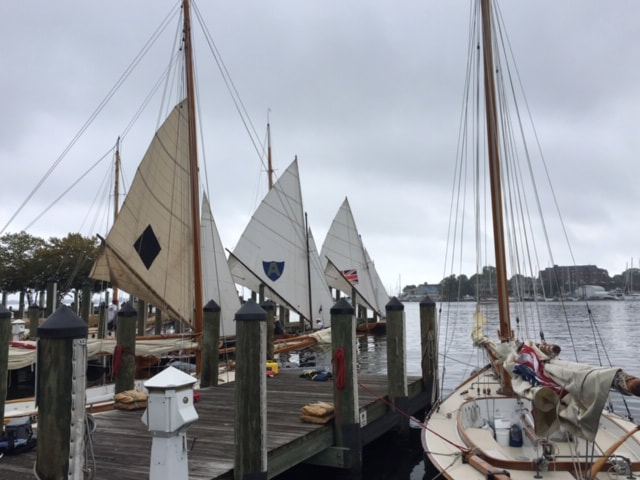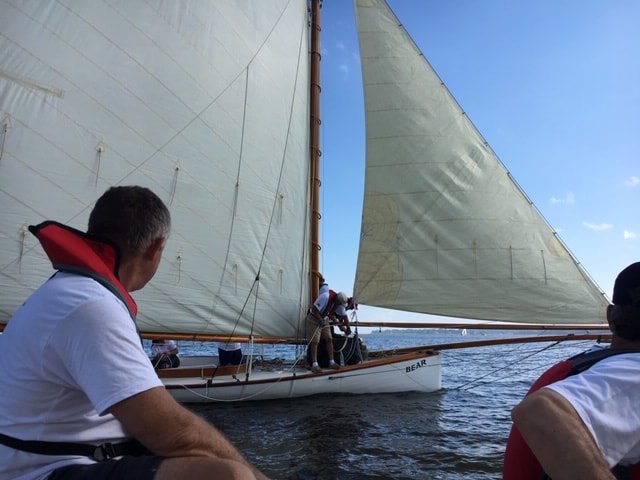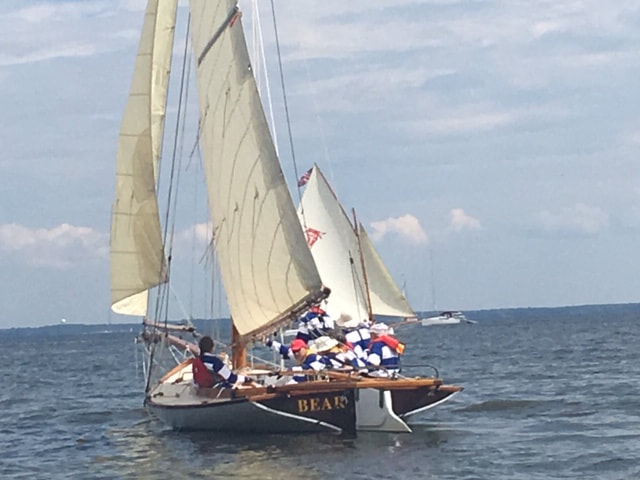Lots of old black and white photographs show big beamy boats with a huge press of sail manned by large crews of largely working class blokes. There are stories of heavy gambling and on and off the water fights. The boats themselves started off as working boats. Sounds familiar? We could be describing the Sydney eighteen footers or the American sandbaggers. The similarities have led a number of people to assume that the the sandbaggers had a lot to do with the evolution of the eighteen footers. But did they? Well....a bit. Not directly, but through one essential feature. Let me explain.
American Sandbaggers in 1884 (Penobscot Maritime Museum) Tangalooma, Sydney and Brisbane 18-footer 1930
American sandbaggers began to develop as a class of racing boat out of the oyster sloops of the Northeastern coastal states in the 1860's and really got going in the 1870's and '80's. They were shallow, beamy hulls with centreboards and plumb stems and sterns (pedants will argue as to the origin of the centreboard as many different cultures had different types around the world for centuries, but the centreboard as we know it was first developed in the 1840's in these Northeastern USA areas in the fishing and oyster fleets). Unrestricted as to sail area, rigs got bigger and boats were built specifically for racing. They generally raced in hull length classes, from about 20 feet to about 28 feet. Many distinctive features evolved such as the jibs being on a boom, and the mainsheet being led down to a large triangular stern outrigger. Bags of sand or more often gravel were used as ballast, and shifted from side to side when tacking by a large crew, though apparently various clubs had differing rules on ballast, some prohibiting shifting it during a race. They set no extras downwind, which must have meant huge weather helm downwind with such a long boom on a mast well forward. Gambling was common on the outcome of races. They died out in the early 1890's.
In the 1860's and early 1870's Sydney open boat racing was in two distinct types of boat. There were ballasted open boats which were generally working boats in the Harbour for taking goods to and from ships and for delivering rocks for ballast and for collecting firewood from up river and shells for lime kilns. By the 1850's a few boats were being built specifically for racing, but most were still working boats, not significantly different from the style of British harbour workboats and Naval workboats. At the regattas which were the main venues for racing they were originally classed into maximum length of keel, but by 1859 they were being classed by overall length and by the 1860's the popular classes were not over 15 feet and not over 22 feet. They were set up as gaff or sprit rigged sloops with a jib set on a short bumpkin off the bow, with gunter rigs being popular for a while in the 1840's and '50's. They raced with gaff tops'ls and downwind with squares'ls.
The other type of racing craft were the watermen's skiffs that were the water taxi of the day and varied from about 18-22 feet in length. They were unballasted, had no centreboards and were designed for rowing as well as sailing, generally with an unstayed lug or sprits'l rig, but some of them also began to use gaff sloop rig with the jib on a bumpkin. Some of the races were held specifically for licensed watermen, others were more open.
In the 1860's and early 1870's Sydney open boat racing was in two distinct types of boat. There were ballasted open boats which were generally working boats in the Harbour for taking goods to and from ships and for delivering rocks for ballast and for collecting firewood from up river and shells for lime kilns. By the 1850's a few boats were being built specifically for racing, but most were still working boats, not significantly different from the style of British harbour workboats and Naval workboats. At the regattas which were the main venues for racing they were originally classed into maximum length of keel, but by 1859 they were being classed by overall length and by the 1860's the popular classes were not over 15 feet and not over 22 feet. They were set up as gaff or sprit rigged sloops with a jib set on a short bumpkin off the bow, with gunter rigs being popular for a while in the 1840's and '50's. They raced with gaff tops'ls and downwind with squares'ls.
The other type of racing craft were the watermen's skiffs that were the water taxi of the day and varied from about 18-22 feet in length. They were unballasted, had no centreboards and were designed for rowing as well as sailing, generally with an unstayed lug or sprits'l rig, but some of them also began to use gaff sloop rig with the jib on a bumpkin. Some of the races were held specifically for licensed watermen, others were more open.
Original builder's model of Truant, 1853, 2 1/2-3 tons, Robert Fish of New Jersey. The first centreboarder to arrive in Sydney in 1854 was a larger version of this boat built in England.
Arrival of the centreboard in Sydney
In March 1854 a Sydney businessman, Sidney C Burt imported an English half-decked yacht named Presto from England, which happened to have a centreboard. Starting to research the background of this yacht, I was led by some mid-twentieth century research which suggested this boat was a copy of the centreboarder Una built by Bayonne New Jersey boatbuilder Robert Fish, which had been send to Solent area in England in the early 1850's and had been very successful in racing and had spawned a lot of English copies. The problem was that Una had a cat rig, ie single sail on mast well forward (a rig that's still referred to as Una rig in Britain) and descriptions of Presto racing in Sydney described her as having jibs and a tops'l and squares'l. Further research showed that another Robert Fish boat, Truant had been imported to England to the Liverpool area about the same time, and Presto was a Liverpool-built copy of this boat. S.C.Burt had bought the successful Presto while on business in Liverpool and shipped it out to Australia.
Presto was about 27' long and was variously rated at between 5 1/2 and 9 tons (tonnage ratings were in a state of flux at the time) and made its debut on Sydney Harbour on 3 April 1854 in a challenge match with the local yacht Frolic for a stake of fifty pounds a side, which Presto won by five minutes. In the Balmain Regatta of November 1854 Presto came second in the “All Yachts” race (to Eclipse, a much larger yacht, Frolic third), but capsized in the Anniversary Regatta of January 1855. Burt must have got a fright and sold Presto in February or March 1855 and imported a deep keel yacht in 1857. Meanwhile back in Liverpool, Mr Bower had got Kelly to build him another centreboarder, the Challenge, 7 ½ or 8 tons, 27’4” on the keel, 9’ beam, yellow pine on oak, with bigger sails than Presto. It was reported to have some “extraordinary performances on the River Mersey” in the 1854 season. Bower must have liked the price he got for Presto because after only one season he sent Challenge out to Sydney to be sold on spec, and it arrived in March 1855 and was sold to T.J.Dean. Challenge won the All Yachts over 3 tons race at the Anniversary Regatta in 1856, beating Presto, which had been sold again and lengthened by ten feet at Holdsworth’s yard which seemed to ruin its racing qualities.
In March 1854 a Sydney businessman, Sidney C Burt imported an English half-decked yacht named Presto from England, which happened to have a centreboard. Starting to research the background of this yacht, I was led by some mid-twentieth century research which suggested this boat was a copy of the centreboarder Una built by Bayonne New Jersey boatbuilder Robert Fish, which had been send to Solent area in England in the early 1850's and had been very successful in racing and had spawned a lot of English copies. The problem was that Una had a cat rig, ie single sail on mast well forward (a rig that's still referred to as Una rig in Britain) and descriptions of Presto racing in Sydney described her as having jibs and a tops'l and squares'l. Further research showed that another Robert Fish boat, Truant had been imported to England to the Liverpool area about the same time, and Presto was a Liverpool-built copy of this boat. S.C.Burt had bought the successful Presto while on business in Liverpool and shipped it out to Australia.
Presto was about 27' long and was variously rated at between 5 1/2 and 9 tons (tonnage ratings were in a state of flux at the time) and made its debut on Sydney Harbour on 3 April 1854 in a challenge match with the local yacht Frolic for a stake of fifty pounds a side, which Presto won by five minutes. In the Balmain Regatta of November 1854 Presto came second in the “All Yachts” race (to Eclipse, a much larger yacht, Frolic third), but capsized in the Anniversary Regatta of January 1855. Burt must have got a fright and sold Presto in February or March 1855 and imported a deep keel yacht in 1857. Meanwhile back in Liverpool, Mr Bower had got Kelly to build him another centreboarder, the Challenge, 7 ½ or 8 tons, 27’4” on the keel, 9’ beam, yellow pine on oak, with bigger sails than Presto. It was reported to have some “extraordinary performances on the River Mersey” in the 1854 season. Bower must have liked the price he got for Presto because after only one season he sent Challenge out to Sydney to be sold on spec, and it arrived in March 1855 and was sold to T.J.Dean. Challenge won the All Yachts over 3 tons race at the Anniversary Regatta in 1856, beating Presto, which had been sold again and lengthened by ten feet at Holdsworth’s yard which seemed to ruin its racing qualities.
Sail plan and lines of Sandbagger "Cruiser" of 1868
Left: Lines of unidentified 22-footer, drawn by Bill Bollard from a model in the collection of Jack Hamilton. Right: Lines of Eighteen footer Britannia, 1919. ( Australian National Maritime Museum)
When you’re on a good thing, stick to it thought A.Bower in Liverpool and had Phillip Kelly build him another one in 1855. Spray was also about 8 tons, planked in yellow pine on oak. He kept this one for two seasons before sending it to Sydney where it arrived in early January 1857 and was bought by the same T.J.Dean who owned Challenge. Other owners commissioned local boatbuilders to copy them, and White Squall, Scud, and Sylph had appeared by 1858-9. Bower did it for a fourth time with Kelly, this time the Charm, also built of yellow pine on oak and about 8 tons, but with more sail area than the other three. It arrived at the end of December 1858 and was purchased by the Croft brothers for one hundred and fifty pounds. It first raced in the Anniversary Regatta a few weeks later and came second to Challenge. In 1859 Charm won the Balmain Regatta race for yachts with centerboards fixed. Wait a minute, centerboards fixed!? What’s that all about?
As almost invariably happens in sailing, whenever a new boat appears that is different to most of the boats currently sailing, and it wins, the other owners get upset. That is exactly what happened with Presto and her sisters. They were called freaks, were deemed unseaworthy (well they did capsize and sink, didn’t they?), and though they didn’t actually use the term, it was hinted that they were un-British. They were accused of being only capable of racing in protected waters and not being capable of cruising and all those other things that trained our hardy young men to be seamen who could be useful to the Empire!
So the first reaction was to ban them. It took several seasons for the resentment to build up. The recently formed Sydney Yacht Club (which soon became the Royal Sydney Yacht Squadron) was split between centreboard owners and deep keel owners. It almost broke up when the deep keelers threatened to leave in November 1857, but their tactic seems to have worked because the Club rules were changed to prohibit centreboard boats. It may have helped them that S.C. Burt, the man who imported Presto changed sides as he had imported Surprise, an English deep-keeler in 1857, and T.J. Dean who owned both Challenge and Spray, for some time simultaneously, bought Mischief, a deep keeler while retaining both of the others and so had a foot in each camp. The same owners kicked up when the January 1858 Anniversary Regatta committee were going to allow centreboard yachts in the first-class yacht race, so they dropped the lip and held a private race on the same day in the same waters. This did the trick, and in the 1859 Anniversary Regatta there were separate races for centreboard yachts and deep keel yachts. In the Balmain Regatta centreboards were allowed until the 1857 event where they were excluded entirely, and again in 1858. In 1859 centreboard yachts were allowed but as noted before, they had to have their centreboards fixed. Only two of each type turned up, and as it was still won by Charm they were banned for the next few years.
As almost invariably happens in sailing, whenever a new boat appears that is different to most of the boats currently sailing, and it wins, the other owners get upset. That is exactly what happened with Presto and her sisters. They were called freaks, were deemed unseaworthy (well they did capsize and sink, didn’t they?), and though they didn’t actually use the term, it was hinted that they were un-British. They were accused of being only capable of racing in protected waters and not being capable of cruising and all those other things that trained our hardy young men to be seamen who could be useful to the Empire!
So the first reaction was to ban them. It took several seasons for the resentment to build up. The recently formed Sydney Yacht Club (which soon became the Royal Sydney Yacht Squadron) was split between centreboard owners and deep keel owners. It almost broke up when the deep keelers threatened to leave in November 1857, but their tactic seems to have worked because the Club rules were changed to prohibit centreboard boats. It may have helped them that S.C. Burt, the man who imported Presto changed sides as he had imported Surprise, an English deep-keeler in 1857, and T.J. Dean who owned both Challenge and Spray, for some time simultaneously, bought Mischief, a deep keeler while retaining both of the others and so had a foot in each camp. The same owners kicked up when the January 1858 Anniversary Regatta committee were going to allow centreboard yachts in the first-class yacht race, so they dropped the lip and held a private race on the same day in the same waters. This did the trick, and in the 1859 Anniversary Regatta there were separate races for centreboard yachts and deep keel yachts. In the Balmain Regatta centreboards were allowed until the 1857 event where they were excluded entirely, and again in 1858. In 1859 centreboard yachts were allowed but as noted before, they had to have their centreboards fixed. Only two of each type turned up, and as it was still won by Charm they were banned for the next few years.
The battle raged for almost two decades, alternately swinging either way. In the Balmain Regatta, for example: 1864-67 separate races for with and without; 1869-74 fins to be fixed, and not until 1875, 21 years after the arrival of Presto were they allowed to lift their fins. By the late 1860’s, the original centreboard yachts were not appearing very often, and the rules mostly applied to all the other classes of boats that now had centreboards. We have to remember that Presto and all of the others were considered as yachts: they were half-decked, but they were ballasted and mostly coppered and kept afloat. They were referred to as “skimming dishes” but they were only light compared to the deep keelers of the day. But the usefulness of the centreboard was not lost on owners and builders of smaller boats. They also wouldn’t have missed that American whaleboats with centreboards were beginning to appear in Sydney by 1855. The first race programme to mention centreboards on smaller boats was the North Shore Regatta on the Queen’s Birthday holiday on 24 May 1858. A race was held for centreboard dinghies, and three boats fronted. Mind you, the programme also had no less than four other races for open boats without centreboards so there were plainly far more boats without than with at this point. The 1859 Anniversary Regatta had four entries for a centreboard dinghy race, Daring, Meteor, Tom Bowling and Surprise. There was still some resistance from organisers: the committees of the 1858 Balmain Regatta and the Hunters Hill Amateur Regatta refused to allow races for centreboard dinghies. The owners staged a private race on the same day in the same waters.
Left: A 19-foot skiff in 1878. Right: Sketch of a 22' skiff. The 22', 19' and 16' skiffs of the 1870's and '80's were restricted to 6' beam and 20" depth.
It took a while, but eventually numbers of centreboard dinghies and skiffs reached critical mass and by 1864 most regattas had started holding separate races for open boats with centreboards and those without, but in the 1865 Balmain Regatta the race for open boats not greater than 22’ with fins and centreboards excluded (the old working boat style) was still considered the feature of the day, there was a considerable amount of betting, the fleet was numerous, and at least one boat was brand new. But by 1870 there were no longer separate races, although fins and centreboards had to be fixed. By 1874-5 boats were able to lift their fins, and they just don’t rate a mention after that. It is significant that this period coincided with the emerging development of distinct classes of skiffs determined by length, and the development of a class of centreboard fishing boats, both of which had a huge impact on the evolution of the open boat.
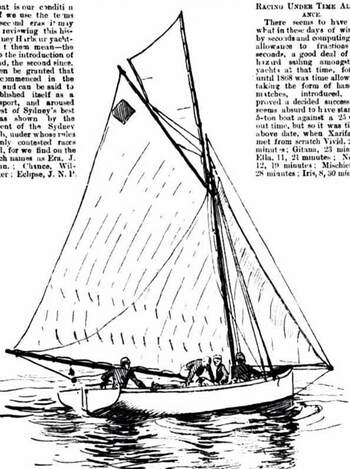
Left: Newspaper sketch of 24 foot gentlemen's fishing boat Adelphi of approximately 1875. Boats like this and the 16',19' and 22' racing skiffs were contemporaneous with the Sandbaggers but quite unlike them.
Were any of these boats similar to the Sandbaggers? No they weren't. The centreboard skiff classes formed into 3 classifications according to length, 16 feet, 19 feet and 22 feet, all restricted to 5 feet beam and 20 inches depth (gun'l height to keel amidships). All carried large gaff sloop rigs with long curved bumpkins (what would be referred to as bowsprits in other boats have always been referred to as bumpkins in skiffs). They all set gaff tops'ls , and squares'ls downwind. The 24' Fishing Boats that began to race as a class in the early 1870's had evolved out of professional fishing boats, but the new ones were chiefly owned by amateurs and used for gentlemen's pursuits like camping, fishing and duck shooting as well as sailing. They were generally around 7-8 foot beam and over 3' depth and had moderate rigs, and carried ballast, usually of lead or iron. Over the next two decades the 24's began to get beamier and carry more sail, particular after the mid-1880's, when a similar class of 22 foot boats emerged and became the dominant class in the 1890's. But the closest they came to being Sandbaggers was when Brisbane boatbuilder Peter Wood of Kangaroo Point built Yapina on Sandbagger lines in 1886. Yapina was 22 foot long, 10 foot beam and 2'6" deep, carried 10 crew and 9 hundredweight (457 kg) in sand ballast and carried "more sail than any other boat of her length on the river" according to a contemporary report which also described her as being "of curious build". The owner acknowledged her American roots by displaying the Stars and Stripes as her sail insignia. The boat raced with moderate success against other Brisbane 22's for several years but was outclassed by newer 22's by the mid-1890's and is last heard of in 1899. But it is clear that in resembling a Sandbagger she was significantly different from the locally-designed boats. And at the exact time she was built, local open boat classes were evolving the big beam, wide tuck, steep deadrise hulls that led to the huge sail carriers of the late 1890's, and then to the development of the eighteen footers as the dominant class after 1902-3 on similar lines to the big beam 22 footers.
Were any of these boats similar to the Sandbaggers? No they weren't. The centreboard skiff classes formed into 3 classifications according to length, 16 feet, 19 feet and 22 feet, all restricted to 5 feet beam and 20 inches depth (gun'l height to keel amidships). All carried large gaff sloop rigs with long curved bumpkins (what would be referred to as bowsprits in other boats have always been referred to as bumpkins in skiffs). They all set gaff tops'ls , and squares'ls downwind. The 24' Fishing Boats that began to race as a class in the early 1870's had evolved out of professional fishing boats, but the new ones were chiefly owned by amateurs and used for gentlemen's pursuits like camping, fishing and duck shooting as well as sailing. They were generally around 7-8 foot beam and over 3' depth and had moderate rigs, and carried ballast, usually of lead or iron. Over the next two decades the 24's began to get beamier and carry more sail, particular after the mid-1880's, when a similar class of 22 foot boats emerged and became the dominant class in the 1890's. But the closest they came to being Sandbaggers was when Brisbane boatbuilder Peter Wood of Kangaroo Point built Yapina on Sandbagger lines in 1886. Yapina was 22 foot long, 10 foot beam and 2'6" deep, carried 10 crew and 9 hundredweight (457 kg) in sand ballast and carried "more sail than any other boat of her length on the river" according to a contemporary report which also described her as being "of curious build". The owner acknowledged her American roots by displaying the Stars and Stripes as her sail insignia. The boat raced with moderate success against other Brisbane 22's for several years but was outclassed by newer 22's by the mid-1890's and is last heard of in 1899. But it is clear that in resembling a Sandbagger she was significantly different from the locally-designed boats. And at the exact time she was built, local open boat classes were evolving the big beam, wide tuck, steep deadrise hulls that led to the huge sail carriers of the late 1890's, and then to the development of the eighteen footers as the dominant class after 1902-3 on similar lines to the big beam 22 footers.
22 footer Vigilant (1896). The beamy 22 footers evolved out of the 24' fishing boats and the narrower 16', 19' and 22' skiffs. They were replaced by the 18 footers after 1902-3, and owe only their centreboards to the Sandbaggers. (Hall collection, ANMM).
The judgement that the Eighteen footers became the dominant racing class in 1902-03 is based on the fact that it was in that season that the prize money at the big regattas offered to the eighteens surpassed that offered to the twenty-twos. Only a handful of 22-footers continued to race after this, and chiefly races with limited sails and crews, both in Sydney and Brisbane. The eighteens prospered, and though they continued to evolve in the twentieth century, mostly through the influence of the narrower skiff-type hulls that appeared from time to time with mixed success but led to the dominance of the skiff-type after the arrival of Aberdare in 1932. But this evolution was all locally-derived, and foreign influences didn't start until the 1950's, but that's a whole other story.
Back to 1854: Robert Fish's Truant and Una were not sandbaggers, but the racing sandbaggers did evolve out of boats like that. Australia was introduced to the centreboard through the arrival of similar boats, but centreboards had a long controversial introduction here and by the time they were accepted, their use was chiefly in locally-derived types of boats that evolved into the 22 footers and eventually into the 18 footers. So in evolutionary terms, while the eighteens are not direct descendants of the Sandbaggers, through the adoption of the centreboard you could say that they do both have a common ancestor.
The whole story of the evolution of the 18-footer can be found in The Open Boat book. You can read more about the Sandbaggers in the June 1994 WoodenBoat magazine, Number 118. A great article by historian Ben Fuller.
The judgement that the Eighteen footers became the dominant racing class in 1902-03 is based on the fact that it was in that season that the prize money at the big regattas offered to the eighteens surpassed that offered to the twenty-twos. Only a handful of 22-footers continued to race after this, and chiefly races with limited sails and crews, both in Sydney and Brisbane. The eighteens prospered, and though they continued to evolve in the twentieth century, mostly through the influence of the narrower skiff-type hulls that appeared from time to time with mixed success but led to the dominance of the skiff-type after the arrival of Aberdare in 1932. But this evolution was all locally-derived, and foreign influences didn't start until the 1950's, but that's a whole other story.
Back to 1854: Robert Fish's Truant and Una were not sandbaggers, but the racing sandbaggers did evolve out of boats like that. Australia was introduced to the centreboard through the arrival of similar boats, but centreboards had a long controversial introduction here and by the time they were accepted, their use was chiefly in locally-derived types of boats that evolved into the 22 footers and eventually into the 18 footers. So in evolutionary terms, while the eighteens are not direct descendants of the Sandbaggers, through the adoption of the centreboard you could say that they do both have a common ancestor.
The whole story of the evolution of the 18-footer can be found in The Open Boat book. You can read more about the Sandbaggers in the June 1994 WoodenBoat magazine, Number 118. A great article by historian Ben Fuller.
In September 2017 the Sydney Flying Squadron took three Historical 18-footers to Annapolis Maryland to sail with the two Sandbaggers there, Bull and Bear. We also sailed three races on one Sandbagger with a rotating Australian team against a rotating US team. We won 2-1. In light conditions the Aussie 18's were faster, but we had our big rigs, whereas the Sandbaggers only had intermediate rigs. It may have been different either in more breeze or with their big rigs.
